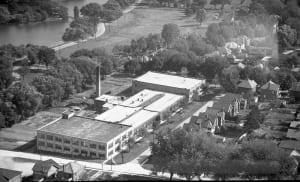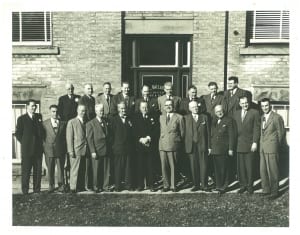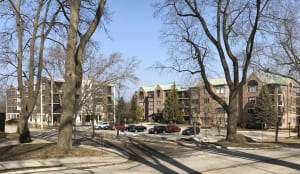The following article appears in the January 2021 newsletter of the Stratford-Perth branch of Architectural Conservancy Ontario; in this version, I’ve made minor edits.
The R.M. Ballantyne Ltd. textile plant was built by a thread company, which ran into financial difficulties, and was first occupied by a motor company which built a bus, that startled the horses
By Jaan Pill
The first thing to know about the R.M. Ballantyne Ltd. textile plant in Stratford, Ontario on Ballantyne Avenue between North Street and Front Street, is that the plant was not built by the Ballantyne family.

Aerial view of R.M. Ballantyne Ltd. textile plant on Ballantyne Avenue between North Street and Front Street, Stratford. The land in this area slopes from Water Street (which runs parallel to Ballantyne Avenue) to the Avon River, indicating (with reference to the physiographic history of Southern Ontario) that a large river flowed through this area after end of last Ice Age over 10,000 years ago. Photo source: I believe it’s from Stratford-Perth Archives
I was most interested to recently read an article by Thomas Joseph Dolan – the illustrious Stratford personality after whom both T.J. Dolan Drive and the T.J. Dolan Natural Area are named. The article, for which I do not have a date, is entitled: “Who built the plant on Ballantyne Avenue?”
Dolan spent much of his life working at the Stratford Beacon Herald, before retiring as managing editor in December 1966. His article was published sometime around the late 1960s, when the Ballantyne plant was occupied by Scholar’s Choice and Harlequin Enterprises.
Dolan’s article underlines the fact that the Ballantynes had no involvement with the building of the plant. Until I read the article, courtesy of the Stratford-Perth Archives, I assumed that the Ballantynes were indeed the builders. After all, it was named after a member of the Ballantyne family, and was located on Ballantyne Avenue.
Dolan reports that the original building (before subsequent additions) was, instead, built for a thread company which, however, never occupied it. The building’s original occupant was a motor company, which built one bus.
The story begins in 1905 when Thomas Ballantyne – a teacher, politician, proprietor, and reformer, who in the 1860s had built the cooperatively owned Black Creek Cheese Factory near Sebringville – sold the land, near the Avon River, to William Gordon, after which it was subdivided.
What happened next was that the Dominion Thread Company Ltd. of Toronto was all set to start operations, on what was then a vacant site. The company hired J.W. Siddell, a Toronto architect, to design a manufacturing plant for the site.
The contractor was Lt. Col. John L. Youngs, a prominent builder and military figure who got the building erected, in 1905 as I understand, but had trouble getting paid. That’s because, in 1906, the thread company ran into financial difficulties, and never began operations at the new building. The Kurtze & McLean Gasoline Engine Company, which was going to build buses, subsequently acquired the property, with backing from the city of Stratford. On July 18, 1907, a number of people were treated to a bus ride in Stratford, courtesy of the motor company.
“In its early days,” T.J. Dolan observes, “the bus caused consternation among the horses from the country and several runaways were narrowly averted.” The image of the horses running around helps us picture the times. The motor company didn’t last long; there is no record that more than one bus was built. The city, which was left holding a $10,000 mortgage, consequently got control of the building.
R.M. Ballantyne Company Ltd.
In 1908, the R.M. Ballantyne Company Ltd. enters the picture. The company was originally located at a three-storey building at the southeast corner of Waterloo and Albert Streets. The company manufactured knitted goods and dairy supplies (until May 1909) and handled cheese.

Office staff, R.M. Ballantyne Ltd. Knitting mill. Source: I believe it’s from Stratford-Perth Archives
A June 27, 1953 Stratford Beacon Herald article notes that the R.M. Ballantyne Company was formed in 1905 by the amalgamation of the Stratford Knitting Company, the Cardigan Overshoe Company, and the Ballantyne Dairy Supply Company.
By way of digression from T. J. Dolan’s article, we can mention that in its marketing material, R.M. Ballantyne Ltd. asserted that, “This Company, though only established in 1903 [as the Stratford Knitting Company], was the first Company in Canada to manufacture the high class Worsted Gloves and Mittens now so much in fashion and favor, and which bear the Beaver Brand.”
“These goods,” the company proclaimed, “met with such marked approval from the first from the public and the trade, that the Company extended its line of manufacture to Toques, Sashes, Jerseys and Sweaters, and these also carrying the Beaver Brand, are equally favorably known from the Atlantic to the Pacific. The goods are all made from the best imported yarns, they are all guaranteed, are taking well, and the trade is growing beyond expectation.”
The R.M. Ballantyne Company offered (we return now to highlights from Dolan’s article) to retire the city’s $10,000 debenture debt over a 20-year period, install a new boiler, complete the plant’s unfinished portions, and “employ 50 persons at the start and 100 within a year.”
“Six building lots from the original site were retained by the city,” reports Dolan, “which also undertook to provide walks on Front and North Streets and install sewage and drainage systems.”
The company moved to the building in August 1908, and in 1912 doubled its capacity. Robert Mitchell Ballantyne of Montreal, son of Thomas Ballantyne, served as president of the company, which “reached its employment peak during the Second World War, when more than 200 persons were employed, working mostly on war orders for the Canadian, United States and British governments. The machines operated around the clock.”
To be precise, the machines actually operated almost around the clock; there was a 45-minute gap each day used for maintenance, according to a Jan. 15, 1946 Stratford Beacon Herald article, which adds that from 1939 to 1945, war production at the plant “accounted for about half of the work done by R.M. Ballantyne Ltd.” Thus, the plant did not do “mostly” war work during the Second World War.
In 1948 a London investment firm, Isard-Robertson, Dolan reports, took control of the company. Operations continued until May 1954, when the plant was closed leaving about 80 persons out of work. It re-opened between August and December 1954, to fill a special order employing about 40 people.
In April 1955, the company announced that Isador Rosan, president of Cambridge Knitwear Mills of Winnipeg, would take over part of the plant on a lease-buy option, the remainder to be sublet. Operations began in May 1955 with Nathan Kraven, president of Kraven Knitting Ltd.,125 Erie Street, as plant superintendent.
Isador Rosan subsequently gained control of the Ballantyne company through stock purchases but ran into financial problems, after which Mayer Bakel of Winnipeg took over operations, changing the name to Olympic Knit and Sportswear Ltd., with Nathan Kraven as manager. Bakel died in 1965, after which Kraven took over the business in 1966 under the name of Kraven Knitting Ltd., and then vacated the building in 1968, moving to the former Williams-Trow plant on Erie Street.
In December 1962, Jack Hood had begun to use the Ballantyne building for his school supplies business. (I do not know the details of the usage as some words are missing from the photocopy at the Stratford-Perth Archives.) Hood subsequently bought the building in 1967, and in 1968 (according to Dolan’s article; elsewhere I’ve read it was in 1969), sold his business to Harlequin Enterprises Ltd. of Winnipeg. At about the same time, Harlequin bought Nor-Ed Supplies Ltd. of North Bay. Hood’s business and Nor-Ed merged to become Scholar’s Choice and Learning Concepts Ltd. At the time of Dolan’s article, Harlequin and Scholar’s Choice were sharing the building.
Hotel proposal
The building was demolished about 1982 according to a Stratford mapping website launched by Hayden Bulbrook, which notes that, “Proposals were made in 1982 to convert the factory into a museum or develop the site into a luxury hotel and convention centre.”
A Feb. 20, 2013 Stratford Beacon Herald article, entitled, “Original site plan approved in 1985,” describes construction of a condo called Thirty-Six Front, after its street address. “The land had been earmarked,” the article notes, “for two condo developments several years ago and plans had been approved. David Carroll, the city’s chief building official, said the original site plan for the entire site was approved in 1985. The existing condominium building [The Huntington, 30 Front Street] was constructed shortly after but the rest of the site was left vacant.”
Local residents have told me that some developers had originally proposed to build a seven storey hotel at the former textile plant site. The proposal – for a hotel, to be named Park Theatre Place, on the Stratford parklands – was opposed by many but not all Stratford residents.
Opponents of the proposal launched a well-organized response, which began with a letter to the editor at the Stratford Beacon Herald. Many such letters followed. Concerns were expressed about commercialization of the neighbourhood. So many residents became concerned (or at least curious) about the proposal, that it was necessary to raise funds for the rental of meeting spaces. After the meetings, residents would walk home together to their respective homes, discussing the evening’s debates. The challenge brought neighbours together, giving rise to a more tightly knit community.
Prior to a decisive meeting at Stratford City Hall, area residents built a mock coffin, which was painted black, and on which a sign was displayed announcing, “Death of the Park System.” The neighbours carrying the coffin started probably around Queen Street and marched down the middle of Ontario Street, forming a long, straggly line, led by a bagpiper from Water Street. One participant, a local resident named Joyce, recalls that she was concerned that some of her work colleagues (she was working at Scholar’s Choice) would see her marching. “I can remember walking down the middle of the road,” she recalls, “and in a way, I was kind of embarrassed because I thought, you know, I worked with a lot of people, and I thought, oh my, I wonder what they’ll think of me, you know, but it was fun.” The procession arrived at a City Hall meeting tightly packed with citizens.
Among other stories that stand out, from recent interviews, is one regarding comments made at a public meeting by a local resident, now deceased, who lived across the street from the Ballantyne site. At the meeting in question the resident, a carpenter named Garnet Lucas who arrived still in his work clothes, expressed a strong concern that on a fine Sunday morning, as he was preparing to come downstairs for breakfast, an unexpected event – involving the smell of bacon – would occur, that would spoil his day.
“We had a man on upper Ballantyne,” a local resident named Kathryn recalls, “and he would rush into these meetings. He wouldn’t have time to go home and change or anything. So, he’d rush into the meeting, when he got home, and I’ll never forget this one time, he says: ‘Now I suppose, no doubt the front of this building will be facing the river drive. So, at the back, we’ll have all the food trucks coming in. I’ve just put a new picture window in my house. So, I’m gonna look out on that.’ And then, he says: ‘Plus the fact that, some Sunday morning, I’m gonna wake up, and I’m going to think, oh my wife, she’s got a beautiful breakfast coming in, and I’ll get down, and she won’t have breakfast at all: it’s the fumes coming from the hotel!’ So, he was quite the character.”
Stratford city council in the end quashed the hotel proposal. Instead, two condos, which fit in well with the streetscape and park system, were built at the site. The first condo was going to be eight storeys but following objections was lowered to four.
*
I owe the deepest gratitude to the residents who told me about the hotel story, and to staff at the Stratford-Perth Archives, who shared details about the knitting mill. To learn more about the Ballantyne family, I recommend a highly informative PhD dissertation by Hayley Goodchild, entitled: “Building ‘a natural industry of this country’: an environmental history of the Ontario cheese industry from the 1860s to the 1930s” (2017). You can use the ‘find’ function at the PDF of the dissertation (once you’ve downloaded it), to access details about the Ballantynes.

Victor Polley lived at the southeast corner of Front Street and Water Street, a short walk from the knitting mill.
About the author
Jaan Pill is a retired elementary teacher who lives in Stratford.
[End]
Note regarding knitting mill photo
The photo (see above) is of the office staff at R.M. Ballantyne Ltd.; I do not know the date. The version that I’ve scanned for this article was purchased some years ago by a Stratford resident at a shop in Mitchell where batches of photos were on display. Victor Polley is at the extreme right of the photo. He worked at the knitting mill for 17 years before it closed as Nora Polley notes in “Whenever You’re Ready” (2018), p. 49. After the R.M. Ballantyne Ltd. plant closed, Polley worked for 17 years at the Stratford Festival, starting as a bookkeeper and subsequently as an administrator.
I have the names of some but not all people in the photo. Please contact me if you know of names and stories connected with other people in the photo.
Please contact me as well if you can add information and recollections regarding the knitting mill and nearby neighbourhood.
A previous article for Architectural Conservancy Ontario about Stratford is entitled:
Stratford, Ontario: Canada’s cultural tourism destination
How to record oral history interviews
I encourage other residents to record interviews with longtime residents in whichever city or neighbourhood they live.
There’s extensive information available about how to organize and use oral history interviews – for example, you can do a Google search for this topic. A good resource is Steven High of Concordia University; he’s authored and co-authored many studies which focus on the use of oral history in historical research. A note about how I organize my own interviews is available at a post entitled:
You can use an online YouTube editing app to create transcripts of interviews
I also encourage residents to get involved with community self-organizing and with setting up websites like the one you are now visiting:


In the photo of the staff, Stanley Gray is 4th from the left in the front row. He was the father of Doris Gray who married Burt Waters in 1956 in Stratford. Burt’s dad Roy Waters worked for the Dolans at the Beacon Herald for many years.
This is most interesting to know, Ann. I much appreciate you sharing this information. When we can add a name to a photo and a story connected to the name, as you have done, we add something of tremendous value.
In a subsequent message, Ann Belanger has added additional details about Stanley Gray:
He was the father of Doris Gray who married Burt Waters in Stratford in 1956. Burt’s father was Roy Waters who worked for the Dolan family at The Beacon Herald for many years. Burt was instrumental in saving the Gordon Block when the town debated building a parking garage there.